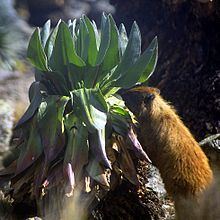Rank Species | Tribe Senecioneae | |
 | ||
Similar Dendrosenecio keniodendron, Lobelia telekii, Dendrosenecio, Lobelia deckenii, Dendrosenecio battiscombei | ||
Dendrosenecio keniensis (syn. Senecio keniensis and S. brassica) is one of the giant groundsels endemic the higher altitudes of Mount Kenya. It is in the family Asteraceae and the genus Dendrosenecio (previously a Senecio). Dendrosenecio keniodendron occurs the upper alpine zone of Mount Kenya and D. keniensis in the wetter areas of the lower alpine or the moorlands.
Contents
Description
Distribution
Senecio keniensis makes its home mostly in the lower alpine or moorland zone located at altitudes of 2,900 metres (9,500 ft) to 3,800 metres (12,500 ft) that can be characterized by high soil moisture, a thick humus layer, similar terrain, and not a lot of different species present. The upper alpine zone, 3,800 metres (12,500 ft) to 4,500 metres (14,800 ft), is more topographically diverse, and contains a more varied flora, including the giant rosette plants Lobelia telekii and L. keniensis, Senecio keniodendron and Carduus spp.. S. keniensis can be found in both the lower and upper alpine zone, although it is less common above 4,000 metres (13,000 ft) where it can regularly hybridise with S. keniodendron.
Name confusion
S. keniensis has a history which includes some confusion between it and other species from other genus which belongs to a different family. There was a mix-up in some of the materials that were collected that united the leaf of Lobelia gregoriana with the inflorescence of S. keniensis. At that time, Senecio keniensis was rejected as a confused name "nomen confusum" based on the muddled samples from which made it impossible to select a single specimen, but that practice is no longer permitted and the replacement name S. brassica is superfluous and other names that were based on this basionym are similarly illogical and incorrectly deduced. Examples: Fries and Fries (1922) cited the confused material for S. brassica; Hedberg (1957) selected a single specimen from among the syntypes that associated S. brassica with Fries & Fries.
